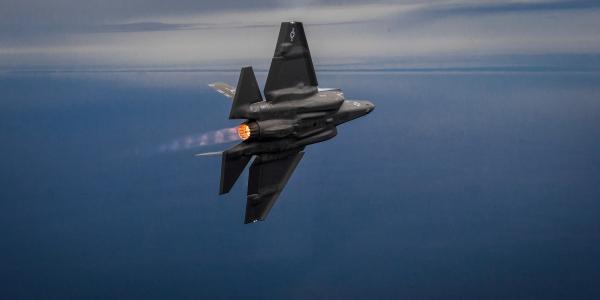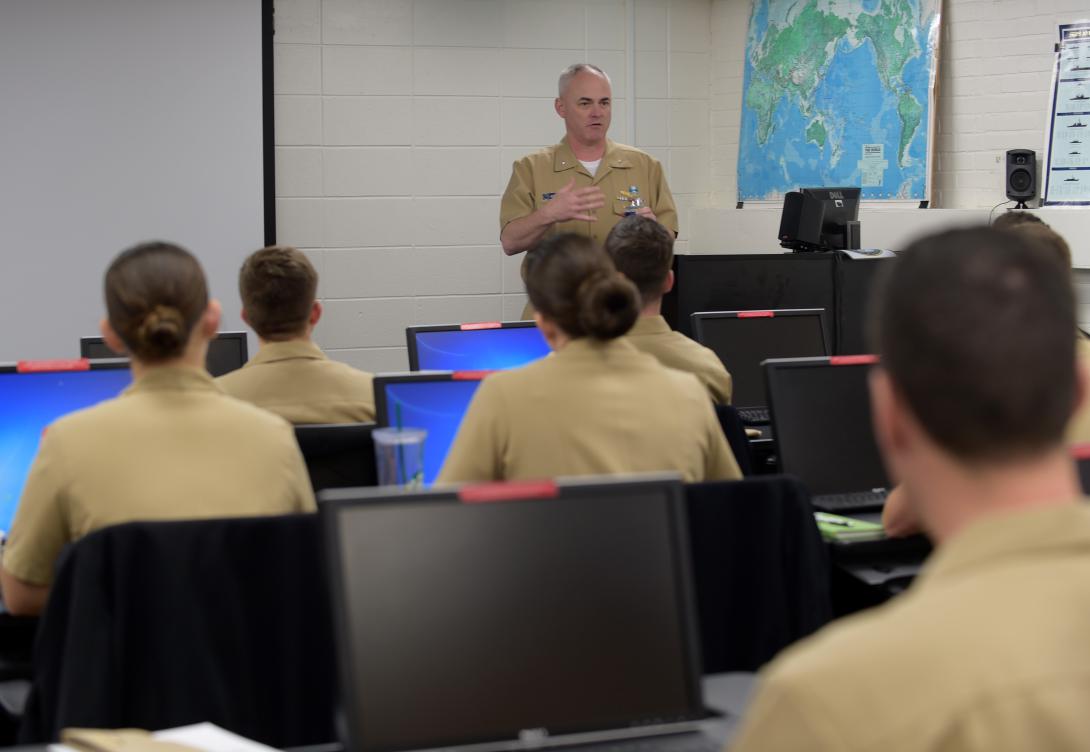Naval Warfighting Embraces the Full Spectrum of Information
The U.S. Navy is massing information to an unprecedented degree to serve its warfighting needs. This effort goes far beyond traditional sensor data fusion: the sea service is drawing data from virtually every corner of the infosphere to arm its people with the information weapons they will need to prevail in a potential great-power conflict.
Two key approaches stand out. First, the Navy is collecting information from across its vast array of data collection elements to paint a unified situational awareness picture for both operators and decision makers. Second, the sea service is adding open-source information to the mix so it can prevail in the war of ideas that defines most conflict scenarios.
The result will be, if planners are right, a maritime force that provides the same information across the breadth of the force. And, the service will be a combatant in the war of ideas that accompanies great-power rivalry.
Rear Adm. Jeffrey Scheidt, USN, commander, Naval Information Warfighting Development Center (NIWDC), says that Navy information disciplines are enjoying a greater prominence than they would have 10 years ago. The service is using information for warfighting as well as for deterrence.
Leveraging the information environment for the increased combat power it provides is a major focus of the Navy’s current strategic emphasis, the admiral continues. With rivals such as China and Russia engaging in major information operations, U.S. Navy forces must be able both to counter their efforts and to use information as a warfighting tool. Through capabilities such as access to big data and the availability of larger scale analytic processes, the Navy now has opportunities to learn about adversaries’ ways and means. This also plays into traditional approaches, he offers.
“The Navy has always been a little bit of a glutton for extra information, because it finds itself disadvantaged because of its isolation during deployments,” the admiral notes. “A ship at sea can be pretty underprivileged with regard to information services.”
Arming its ships with information has been the Navy’s remedy for this isolation. What has changed recently is the availability of different types of data that can be unified into a single picture. The ability to unify these data, especially having visibility across traditional data stovepipes, is opening up new capabilities for the fleet, the admiral says.
Adm. Scheidt offers that the Navy has some slight philosophical differences with its sister services over information warfare (IW). The Navy includes the specialties of meteorology, communications, cryptology and general intelligence in IW, he says. The service also includes an ad hoc cadre of space experts in that community from across the entire Navy. The other services have parsed those same functionalities differently, he adds.
The Navy’s unification of planning capabilities, meteorological data and operational patterns from intelligence sources is more practical given advanced computational power and data access. This was not realistic until recently, and the Navy is “able to do more exotic things in more practical ways,” the admiral emphasizes.
And this breaking of stovepipes is vertical as well as lateral. He describes a growing recognition that data available at the strategic and tactical levels doesn’t have to be different. Decision makers at each level probably need to have the same data in front of them even though they will use it for different purposes, the admiral says. Part of the Navy’s Pentagon-level approach on digital warfare has been to develop structures and emphasis enabling “the broadest possible access and use of gathered data, regardless of whether it’s a tactical use or a strategic use,” he says.
The benefit to this approach is that decision makers at any level can count on their decisions being based on a coherent shared landscape of data, the admiral continues. Each person’s data does not reflect different phenomena than at the strategic or operational levels. “It’s a way to baseline decision making because you’re so broadly sharing and so broadly accessing data,” he points out.
But the second half of the total information equation cuts to the heart of modern-day IW. Not just decision making, but also operations will benefit from wielding unified data. “The speed of conveyance of things that happen even at sea is pretty fast,” Adm. Scheidt states. “In an environment where we’re trying to beat the adversary’s punch with regard to the strategic narrative, we have to do pretty deliberate things to deliver our version of the truth via public media.”
So in addition to arming decision makers and warfighters with data to support their kinetic campaigns, the Navy is adding public information to its warfighting arsenal. “We’re growing into that in a way that is very deliberate right now,” the admiral declares. “It’s a full-on necessity that we will be able to tell an accurate story so that whatever our adversary wants to say in their strategic narrative doesn’t drown out the truth.”
He continues that an adversary may have an agenda “that is not totally wholesome.” If this opponent is trying to make a point and drive the U.S. Navy away from operating in international waters by causing an incident and recording events in a way that supports the adversary’s narrative, then this needs to be countered with accuracy and the speed of delivery that keeps public opinion well informed, he says. In a development that paralleled the admiral’s hypothetical description, last October, U.S. and Chinese destroyers nearly collided in the South China Sea after the People’s Liberation Army Navy craft undertook aggressive moves toward its U.S. counterpart.
“We’re having to deal with a need to document how events are unfolding as we go about our business, to make sure the news cycle appreciates our fully accurate version of the truth, which is an objective counterweight to the spin narrative that could be coming from one of our adversaries,” Adm. Scheidt declares.
These endeavors do not reduce the value of kinetic conflict, he emphasizes. Instead, they increase the potential for deterrence. “As we think about how to effectively avoid conflict, you really have to appreciate the adversary’s calculus about when they might start something and how they might prosecute that—and what calculus they’re using to make those decisions,” the admiral explains. “Appreciating that adversary’s mental model, their sensor grid, the things that will be delivering information that either supports their hypothesis of our behavior or proves to them the timing is right—if we can appreciate what those signals are, what those sensors look like and how the adversary might be interpreting that data, it’s a lot more interesting to try to figure out effective ways to keep them thinking that ‘today’s not the day to start a fight.’”
Gathering all this data, ranging from open source to sophisticated sensor products, requires greater processing capabilities. The Navy needs to rethink how it carries out that processing as it recognizes the need for “real resilience” in how that processing happens, Adm. Scheidt allows. This must apply among multiple levels of warfighting as well as amidst different processes. As the Navy confronts counter-information-flow actions by an adversary, it must have the ability to mitigate those effects, he emphasizes.
Two key points underpin the Navy strategy. One is the Naval Tactical Grid, which would serve as a foundation of the information sharing necessary for providing common data for distributed decision making. That grid must be connected to gear that does the processing, the admiral notes.
The other point is the Compile to Combat in 24 Hours (C2C24) architecture, which will shape that processing by helping standardize the way the Navy processes information as it injects new capabilities into the fleet’s mobile platforms. It also will enable resiliency through common processors, storage devices and network connections. A casualty in one key process can be remedied by pulling gear from a lower priority process at a local level. Replacement capabilities for high-end functions could be tapped seamlessly from these lower levels, the admiral points out.
Feeding that processing will be an advanced and diverse collection of sensors, including traditional radars and exotic modulations. Nontraditional means will feature open-source news, which is “a large global sensor grid” the Navy will tap for learning about adversarial activities. “If not fully depicting reality, it is a portion of that reality and, sometimes, a very deliberately constructed reality when it comes from foreign sources,” Adm. Scheidt professes.
Several challenges confront the Navy as it seeks to incorporate information warfighting fully. Adm. Scheidt explains that the NIWDC faces the task of enabling the Navy to re-prioritize its activities, which in turn will cause some personnel to feel that their decades-long work is less valuable. The shift from great-power competition to counterterrorism changed the focus of U.S. maritime capability. Now, with great-power competition back, behaviors must change again to match the new priorities.
Another issue is that the Navy always will need a vibrant technology innovation culture in IW. Adversaries are nurturing innovation, and the Navy must maintain a technological advantage, the admiral charges. “If we are not deliberately breeding that in our force and rewarding that as behavior, then we’re going to end up not where we want to be,” he states. Accordingly, the Navy must incentivize that behavior.
And the Navy must be able to dovetail information warfighting with the greater joint force. This goes far beyond supporting onshore insurgent suppression and toward enabling a high-end maritime conflict, he notes.
Adm. Scheidt lauds the support his center receives from the highest ranks. “They want us more and faster every day,” he offers. “The recognition that real deterrence and real combat power really can’t be had without strong information warfare has pretty much been accepted across the senior levels of the service.” It is the middle ranks that have faced difficult choices about prioritization of resources, he observes, particularly if their specialty must give up something to make IW stronger.
The admiral offers that leaders need to think about the value metrics that can help make difficult choices in IW-enabled operations. “Just merely respecting scale is probably not the most effective way to move forward.
“We can’t buy our way out of these challenges, we can’t scale everything to solve every problem, so we’re going to have to be clever,” he continues. “And that reality says we’re going to have to think about the world differently than we did during violent extremist operations if we’re going to be successful in great-power competition.”
Because the NIWDC is only two years old, it often encounters a traditional mindset that does not adopt full IW capabilities as an important element of operations, Adm. Scheidt says. “We still run into corners of the Navy that really don’t fundamentally feel comfortable with a general understanding of what information warfare should be providing them,” he states. “I want people across the Navy to appreciate the single statement, ‘Information warfare is about defeating adversary decision making and maximizing naval lethality.’”






Comments